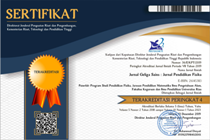Modification of Microcontroller-Based Batik Canting as A Temperature and Viscosity Control of Night Wax
Abstract
The leakage of the wax during the casting of the candle using conventional canting hampers the process of making batik, especially coloring, thereby damaging the motif and reducing the quality of written batik. The solution given is related to the problem of leakage of night wax through E-Canting which is modified from conventional canting using an Arduino nano microcontroller, connected to a temperature sensor, heater plate, and servo to facilitate batik craftsmen in waxing. The use of a microcontroller connected to a temperature sensor to maintain a stable temperature and viscosity of the night wax with the process of releasing the wax is regulated using a lever system that is connected via a servo. The manufacture of E-Canting is carried out in three stages, namely coding through Arduino IDE (Integrated Development Environment) software, assembling components using solder by connecting Arduino nano to other electronic components such as temperature sensors, heater plates, servos, LCDs, and incorporating the E-Canting framework. and electronic components. The energy used by the E-Canting is in the form of electricity which is channeled through the battery so that batik craftsmen can use the E-Canting as needed. The use of E-Canting is able to stabilize the temperature and viscosity of the night wax so as to minimize the occurrence of leakage. E-Canting is able to melt night wax with the required viscosity of 5.54 Pa at 80° in 3.39 minutes which has the potential to increase the amount of quality batik production.
Keywords
Full Text:
PDF (Bahasa Indonesia)References
Abdulmalik, Fety, & Selvi, H., & Derry. (2018). Pengaruh suhu dan komposisi minyak jagung pada pembuatan lilin klowong terhadap pewarnaan batik. Jurusan Teknik Kimia, (April), 1–7.
Adhiyatma, R. (2022). Perancangan dan pembuatan prototipe terminal listrik eksternal t dengan modul timer otomatis menggunakan 3D. Retrieved From Https://Dspace.Uii.Ac.Id/Handle/123456789/37822
Akhiruddin. (2018). Rancang bangun alat pendeteksi ketinggian air sungai sebagai peringatan dini banjir berbasis arduino nano. Journal Of Electrical Technology, 3(3), 174–179. Retrieved From Https://Jurnal.Uisu.Ac.Id/Index.Php/Jet/Article/View/963
Asmi, J., & Candra, O. (2020). Prototype solar tracker dua sumbu berbasis microcontroller arduino nano dengan sensor LDR. JTEV (Jurnal Teknik Elektro Dan Vokasional), 6(2), 54. Https://Doi.Org/10.24036/Jtev.V6i2.108504
Cahyono, H. B., & Yuliastuti, R. (2020). Aplikasi canting listrik pada industri batik tulis untuk mendukung implementasi industri hijau pada industri tekstil pencelupan, pencapan dan penyempurnaan. Jurnal Teknologi Proses Dan Inovasi Industri, 5(2), 67–73.
Hadi, N. F.P.S., & Ghofur, A. (2020). Penggunaan kaolin dengan aditif tembaga sebagai catalytic converter terhadap emisi gas buang dan performa satria F 150. 2(1), 23–38.
Hamid, A., & Setiorini, I. A. (2018). E evaluasi penggunaan isolator pada sistem perpindahan panas suatu alat heat exchanger. Jurnal Teknik Patra Akademika, 9(02), 70–76.
Https://Doi.Org/10.52506/Jtpa.V9i02.80
Lim, Y., & William. (2019). Batik tulis sebagai warisan budaya dunia dalam menanamkan rasa cinta tanah air generasi muda Indonesia. Commed : Jurnal Komunikasi Dan Media, 4(1), 01–15. Https://Doi.Org/10.33884/Commed.V4i1.1297
Mulyono, A., & Ariyanti, E.S. (2010). Otomatisasi Pengukuran koefosien viskositas zat cair menggunakan gelombang ultrasonik. Jurnal Neutrino, 2(2), 183–192. Https://Doi.Org/10.18860/Neu.V0i0.1640
Nasri, N., Asmira, A., & Bakrim, L.O. (2022). Perancangan keran westafel otomatis menggunakan sensor ir dan micro servo berbasis mikrokontroler. Simkom, 7(1), 42–49. Https://Doi.Org/10.51717/Simkom.V7i1.71
Prasetio, M. O., Setiawan, A., Gunawan, R. D., & Abidin, Z. (2020). Sistem pengendali air tower rumah tangga berbasis android. Jurnal Teknik Dan Sistem Komputer, 1(2), 20–25. Https://Doi.Org/10.33365/Jtikom.V1i2.45
Pratama, R. E., Pardede, A. M. H., & Novriyenni. (2022). Rancang bangun mesin cnc mini untuk membuat mini sketsa berbasis arduino. 6(2), 607–618.
Purwanto, A. (2019). Perancangan dan pembuatan pengatur buka tutup tempat makanan otomatis pada kafe berbasis arduino nano. Ubiquitous: Computers And Its Applications Journal, 2, 1–10. Https://Doi.Org/10.51804/Ucaiaj.V2i1.1-10
Rahman, E. S. (2021). Pengembangan alat pengkondisi suhu otomatis rumah walet berbasis mikrokontroler arduino nano. Jurnal Media
Elektrik, 18(3), 49. Https://Doi.Org/10.26858/Metrik.V18i3.23237
Rahmanita, N., Washinton, R., & Ranelis, R. (2020). Pemberdayaan ibu-ibu rumah tangga dan remaja putri melalui pelatihan batik tulis di pusat kegiatan belajar masyarakat (PKBM) Al-Fath. Jurnal Abdimas Mandiri, 4(1), 55–61. Https://Doi.Org/10.36982/Jam.V4i1.1046
Tjahjani, I. K., Hatta, M., & Kunhadi, D. (2020). Peningkatan daya saing IKM batik tulis pendukung implementasi one village one product (Ovop). Jces (Journal Of Character Education Society), 3(2), 329–347.
Triawan, Y., & Sardi, J. (2020). Perancangan sistem otomatisasi pada aquascape berbasis mikrokontroller arduino nano. Jtein: Jurnal Teknik Elektro Indonesia, 1(2), 76–83. Https://Doi.Org/10.24036/Jtein.V1i2.30
DOI: http://dx.doi.org/10.31258/jgs.10.2.161-168
Refbacks
- There are currently no refbacks.
Copyright (c) 2022 Cika Faradila, Sulandari Sulandari, Hilyati Iftinan Lubis, Rangga Prasetyo Darmawan, Sigit Irawan, Rita Juliani

This work is licensed under a Creative Commons Attribution 4.0 International License.
Jurnal ini terdaftar dan terindeks pada:
- Crossref
- Google Scholar
- Crossref
- Garuda
- Sinta
- Researchgate
- Dimensions
- Base
- Scilit
- OneSearch
- Road
- CiteFactor
- ResearchBib
- WorldCat



















